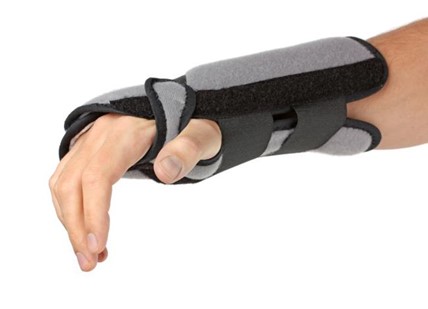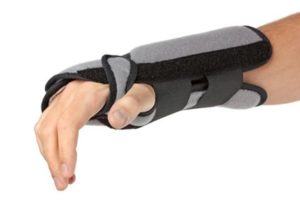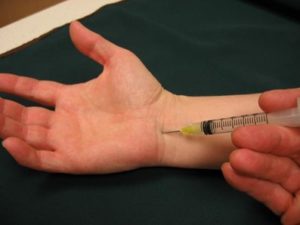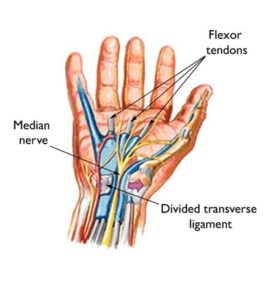
Hello, I am Dr. Ayisha Livingstone, MD, a Fellowship trained and Board-Certified Orthopedic Hand Surgeon. I reside and practice in Fort Lauderdale, Florida with the South Florida Orthopedic Group. I completed my Orthopedic Residency at the University of Miami, and my Fellowship at the University of Pittsburgh.
I genuinely love my community here in South Florida and decided to help bring awareness to common hand and wrist ailments that present in my practice. Once a month I will post a new topic on the website. Please feel free to use the contact information to see me or my colleagues with any questions or concerns.
Carpal Tunnel syndrome… continued
In the June 2022 blog I discussed carpal tunnel syndrome and addressed the symptoms, causes, and examination. I also discussed the specific studies that may be necessary to help evaluate the severity of the syndrome. I had mentioned in the July blog that I would discuss the treatment options in greater detail. Here we go….
Treatment:
Although it is a gradual process, for most people carpal tunnel syndrome will worsen over time without some form of treatment. For this reason, it is important to be evaluated and diagnosed by your doctor early on. Initially, it may be possible to slow or stop the progression of the disease.
Nonsurgical Treatment:
If diagnosed and treated early, the symptoms of carpal tunnel syndrome can often be relieved without surgery. If your diagnosis is uncertain or if your symptoms are mild, I will recommend nonsurgical treatment first.

Nonsurgical treatments may include:
- Bracing or splinting. Wearing a brace or splint at night will keep you from bending your wrist while you sleep. Keeping your wrist in a straight or neutral position reduces pressure on the nerve in the carpal tunnel. It may also help to wear a splint during the day when doing activities that aggravate your symptoms.
- Nonsteroidal anti-inflammatory drugs (NSAIDs). Anti-inflammatory medications such as ibuprofen and naproxen can help relieve pain and inflammation.
- Activity changes. Symptoms often occur when your hand and wrist are in the same position for too long — particularly when your wrist is flexed or extended.
- If your job or recreational activities aggravate your symptoms, changing or modifying these activities can help slow or stop progression of the disease. In some cases, this may involve making changes to your work site or workstation.
- Nerve gliding exercises. Some patients may benefit from exercises that help the median nerve move more freely within the confines of the carpal tunnel. Specific exercises may be recommended by your doctor or therapist.
- Steroid injections. Corticosteroid, or cortisone, is a powerful anti-inflammatory agent that can be injected into the carpal tunnel. These injections often relieve painful symptoms or help to calm a flare-up of symptoms.
- In patients with mild, early disease, injections may relieve symptoms in the long-term.
- In those with moderate to severe disease, the positive effects of the injection may be temporary.
A cortisone injection may also be used to help diagnose your carpal tunnel syndrome. It can be both diagnostic and therapeutic. If effective, we know that carpal tunnel syndrome is the source of your symptoms. Therapeutic, because if it helps then we are both happy.

Steroid injection into the carpal tunnel
Surgical Treatment
If nonsurgical treatment does not relieve your symptoms or provides only temporary relief, I may recommend surgery.
The decision of whether to recommend surgery is based on:
- The severity of your symptoms
- Physical exam findings
- Response to non-operative treatment
- Results of testing
In long-standing cases with constant numbness and wasting of your thumb muscles, surgery may be recommended to prevent irreversible damage. Surgery may also be recommended if you do not get relief with non-operative treatments and/or demonstrate significant nerve changes on testing. It should be known that the goal of the surgery is to stop the progression of the syndrome. It does not guarantee a return of sensation or strength (however, this is likely to occur) which is why early diagnosis and management is so important.
Surgical Procedure
The surgical procedure performed for carpal tunnel syndrome is called a carpal tunnel release.
Most surgeons, including myself, perform this procedure using one of two different surgical techniques, but the goal of both is to relieve pressure on your median nerve by cutting the ligament that forms the roof of the tunnel (transverse carpal ligament). Release of this ligament increases the size of the tunnel and decreases pressure on the median nerve, allowing for appropriate blood flow to the nerve and function of the nerve.

The transverse carpal ligament is cut during carpal tunnel release surgery. When the ligament heals, there is more room for the nerve and tendons.
In most cases, carpal tunnel surgery is done on an outpatient basis. The surgery can be done under general anesthesia, which puts you to sleep, or under local anesthesia, which numbs just your hand and arm. In some cases where local anesthesia is used, you will also be given a light sedative through an intravenous (IV) line inserted into a vein in your arm.
- Open carpal tunnel release. In an open carpal tunnel release surgery, I make a small incision in the palm of your hand and view the inside of your hand and wrist through this incision. During the procedure, I will divide the transverse carpal ligament (the roof of the carpal tunnel). This increases the size of the tunnel and decreases pressure on the median nerve.
- After surgery, the ligament may gradually grow back together in a lengthened fashion, but there will be more space in the carpal tunnel, and pressure on the median nerve will be relieved.
- Endoscopic carpal tunnel release. In endoscopic surgery, I make one or two smaller skin incisions (called portals) and use a miniature camera, or endoscope, to see inside your hand and wrist. A special knife is used to divide the transverse carpal ligament, like the open carpal tunnel release procedure.
The outcomes of open surgery and endoscopic surgery are similar. There are benefits and potential risks associated with both techniques. I will talk with you about which surgical technique is best for you.
I have provided a nice YouTube video link with an animation video of the procedure.
https://youtu.be/BRyaEJf6SYk
Recovery
Immediately after surgery, you will be encouraged to elevate your hand above your heart and move your fingers to reduce swelling and prevent stiffness.
You should expect some pain, swelling, and stiffness after your procedure. Minor soreness in your palm may last several weeks to several months.
Nighttime symptoms improve dramatically for most patients in the first week or so after surgery.
Grip and pinch strength
- Grip and pinch strength usually return by about 2 to 3 months after surgery.
- If the condition of your median nerve was poor before surgery, grip and pinch strength may not improve for about 6 to 12 months.
- In very severe cases, the normal strength you had before you developed carpal tunnel syndrome may not completely return. However, surgery is still important in these cases to prevent worsening of the condition and function of your nerve.
Numbness and tingling
- Numbness and tingling tend to improve over the first several months after surgery.
- Some patients with mild disease may experience return of sensation right away.
- Patients with severe disease may not have normal sensation in their fingertips for 6 to 12 months after surgery.
- In very severe cases, some patients may never completely regain normal sensation. Again, surgery is still important in these cases to prevent the condition from getting worse.
You may have to wear a splint or wrist brace for several weeks after surgery. You will be allowed to use your hand for light activities, taking care to avoid significant discomfort. Driving, self-care activities, and light lifting, and gripping may be permitted soon after surgery.
I will talk with you about when you will be able to return to work and whether you will have any restrictions on your work activities.
Complications
Although complications are possible with any surgery, the surgical team and I will take steps to minimize the risks. The most common complications of carpal tunnel release surgery include:
- Bleeding
- Infection
- Wound healing issues
- Nerve aggravation or injury
Outcomes
For most patients, surgery will improve the symptoms of carpal tunnel syndrome. Recovery, however, may be gradual, and complete recovery may take up to a year.
If you have significant pain and weakness for more than 2 months, I may refer you to a hand therapist who can help you maximize your recovery.
If you have another condition that causes pain or stiffness in your hand or wrist, such as arthritis or tendinitis, it may slow your overall recovery. In long-standing cases of carpal tunnel syndrome with severe loss of feeling and/or muscle wasting around the base of the thumb, recovery will also be slower. For these patients, a complete recovery may not be possible.
Occasionally, carpal tunnel syndrome can recur, although this is rare. If this happens, you may need additional treatment or surgery.
If you feel as if you or any of your family and friends could have any of the symptoms provided here, medical care is available. I am ready and happy to help you keep your hands healthy and functional.
Thank you,
Ayisha Livingstone, MD
Fellowship Trained and Board-Certified Orthopedic Hand Surgeon

